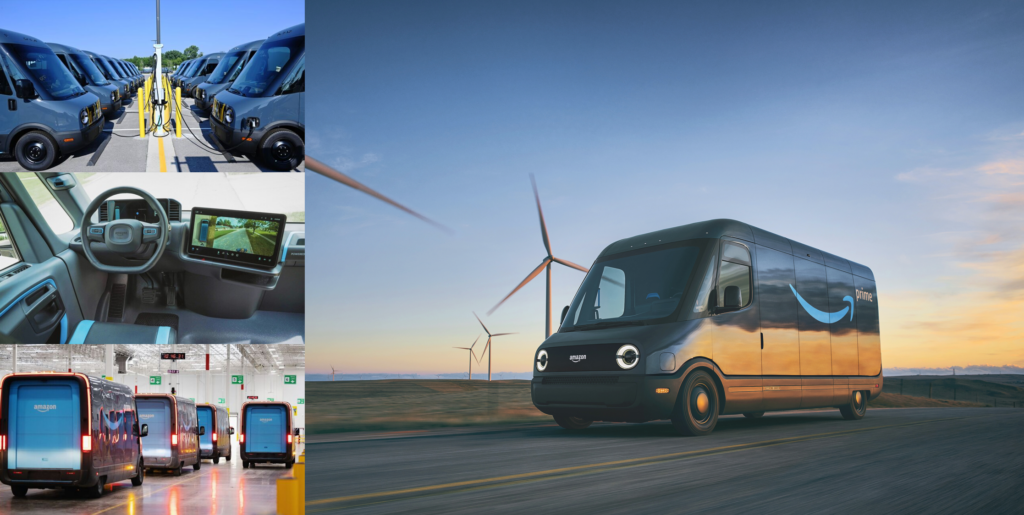Amazon’s bold move to decarbonize its delivery fleet marks a significant step in transforming the logistics industry and addressing climate challenges. By rolling out over 20,000 custom electric delivery vans from Rivian across the U.S., Amazon has made tangible progress toward its goal of achieving net-zero carbon by 2040 under The Climate Pledge. With plans to deploy 100,000 electric vehicles (EVs) by 2030, the initiative is ambitious and underscores the company’s commitment to sustainability.
However, as retail experts at BigBoxBlog, we see both promise and areas for scrutiny in Amazon’s sustainability initiatives.

The Positives: Innovation and Scale
Amazon’s partnership with Rivian represents a new frontier in EV innovation. These vans are designed with advanced features that benefit both drivers and the environment:
- Safety-first design: Enhanced 360-degree visibility, collision warnings, and automatic emergency braking improve both driver and pedestrian safety.
- Driver-centric features: Ventilated seats, ergonomic cabins, and seamless navigation integration help drivers stay comfortable and efficient.
- Sustainability milestones: By delivering hundreds of millions of packages with these EVs, Amazon has potentially cut significant emissions compared to traditional gas-powered vehicles.
Amazon’s scale gives it the power to push for meaningful infrastructure upgrades, such as the 24,000 chargers installed at 150 delivery stations nationwide. Beyond EVs, the company’s testing of e-cargo bikes and e-rickshaws across global markets shows a willingness to innovate in urban environments.
The Challenges: Corporate Accountability
While Amazon’s decarbonization efforts deserve applause, there are key concerns worth addressing:
- Relying on Rivian’s Expansion: Rivian’s ability to meet production demands remains uncertain. Delays could jeopardize Amazon’s 2030 targets, and over-reliance on one supplier creates vulnerabilities.
- Carbon Offsetting vs. Actual Emission Reductions: Net-zero goals often rely on carbon offsets rather than entirely eliminating emissions. Critics argue that companies like Amazon should focus more on actual reductions.
- Sustainability vs. Worker Rights: Reports from delivery drivers in various networks have raised concerns about working conditions. Investing in technology like EVs is vital, but fair wages and reduced workloads for drivers must also be prioritized.
At BigBoxBlog, we’re also curious to see how Amazon balances its aggressive expansion goals with broader industry challenges, such as supply chain disruptions and rising energy costs.
Sustainability Beyond EVs
Amazon’s environmental push extends beyond vehicles. The company has reduced packaging weight by 43% since 2015 and replaced plastic air pillows with 100% recycled paper fillers in fulfillment centers—a notable step given its scale. These changes have avoided over 3 million metric tons of packaging waste, equivalent to the weight of 285 Space Needles.
However, the transition has not been seamless. For instance, customers have reported concerns about insufficient protective packaging in some deliveries, risking damage to products during transit. Balancing sustainability with customer satisfaction is an ongoing challenge.
The Bigger Picture: Implications for Retail
Amazon’s leadership in adopting EVs sends a clear signal to the retail and logistics industries: decarbonization is no longer optional. While smaller retailers may struggle to match Amazon’s investments in green technologies, they could benefit indirectly from Amazon’s push for improved charging infrastructure and advances in EV technology.
Yet, the ripple effects may also create competition concerns. Amazon’s ability to undercut competitors while adopting sustainable practices reinforces its dominance, potentially making it harder for smaller companies to compete fairly. At BigBoxBlog, we believe this duality—Amazon as both innovator and monopolistic force—is central to understanding its role in retail’s future.
Final Thoughts
Amazon’s commitment to decarbonizing its fleet is a step in the right direction for sustainability. The rollout of Rivian EVs, the reduction in packaging waste, and the push for global decarbonization investments showcase Amazon’s capacity to innovate at scale. But success in sustainability cannot be measured solely by glossy headlines or impressive metrics. It requires accountability—ensuring that workers are treated fairly, smaller businesses aren’t left behind, and progress is transparent.
At BigBoxBlog.com, we’ll be closely watching Amazon’s next moves, particularly how its investments in green hydrogen, European EV expansion, and Rivian partnership evolve. For now, Amazon’s electric delivery fleet is a win for the environment—but it’s only one piece of the puzzle in building a sustainable, equitable future for retail.
